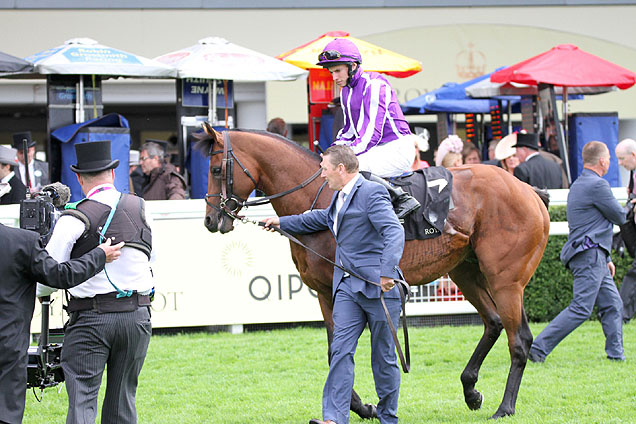3 minute read
Goodwood’s midsummer meeting – traditionally referred to as Glorious Goodwood – may not have quite the cachet of the Cheltenham Festival in March or the international pull of Royal Ascot in June, but it stands on its own feet as an event of significance in the Racing Calendar.

In among some fiercely competitive handicaps and some “they-could-be-anything” maidens, there is a healthy smattering of Group races. Finding winners can be difficult, and this preview will look at the sectional evidence in an attempt to assist.
First, though, an overview of what it tends to take to run well at the track, a tricky and undulating switchback, at which much of the closing stages are downhill but the final furlong rises slightly.Pace varies by-race, and the effects of pace should therefore be viewed on a by-race basis. Remarks to the effect that a certain course is, or is not, suiting front-runners, or hold-up horses, on any given day are usually mistaken.
Unless there is a physical explanation, such generalities are likely to be down to clustering or some other feature. Even when there is a physical explanation (such as a strong wind), it remains perfectly possible for horses to go too fast or too slow and to nullify any perceived positional bias.That all said, every course has different characteristics, topographies and conformations. For instance, if you try to make late ground from the rear at Chester’s almost circular course you are likely to have to come wide or wait for what is a short straight; leaders will slow more in an absolute sense at a course with an uphill finish, like Ascot, than one with a downhill finish, like Epsom.
These characteristics are reflected in the general performances of horses with certain run styles at these courses. What’s more, a feedback loop exists which means that courses you might expect to “suit” front-runners often attract a disproportionate number of front-runners and end up “suiting” (in general, not specific, terms) the opposite.A version of this seems to be at play at Goodwood. A large proportion of races there are truly-run, and horses coming from behind have a good record (again, taken overall).
Looking at all handicaps from 2012 to 2015 inclusive, Goodwood was fifth-worst of 34 turf courses for the % of rivals beaten by horses identified with an early position figure of “1”, indicating a horse which was front-running or pressing the pace early. It was fourth-best (behind Ascot, Haydock and Doncaster) by the same measure for horses with EPFs of “5”, indicating those who were in rear, by accident or design, early on.Expect plenty of truly-run races again this week – in-play punters will undoubtedly be wise to this and to the possibility of races changing markedly late on – but do not be lazy: try to figure out if the particular race in question will conform to the general trend or not.
TUESDAYThe Qatar Vintage Stakes over 7f sees a rematch between Boynton and War Decree, the one-two in Newmarket’s Superlative Stakes last time, and sectionals suggest there will be little in it again, with Boynton carrying a 3 lb penalty. Neither is clearly well ahead of the rest on sectionals, however, with Isomer, Medieval and Larchmont Lad all credible rivals on that score.
Larchmont Lad was especially impressive in winning at Sandown on his only start from next-time winner Maths Prize. The overall time of that race was useful, despite all of the principals coming home quickly. Larchmont Lad ran the last half-mile in a sprightly 50.95s and looks a decent each-way alternative to the likely market principals.A “contested” pace is predicted for the Qatar Lennox Stakes, with the Hugo Palmer-trained pair Home of The Brave and Gifted Master both get-on-with-it types. That, along with the return to 7f, looks right up Dutch Connection’s alley.
The Charles Hills-trained four-year-old is top on sectionals judged on his second to Toormore at Sandown in April and did well enough against a pace bias at Ascot last time. He is a confident selection.The filly Thesme has been on the sectionals radar for some time now, often running well despite going a shade fast. She seems unlikely to get an easy time of it up front in the 5f handicap this time, either, with several speedballs in opposition, and this could set up for something coming from the back.
Maljaa shaped quite well last time at Ascot in a race in which the leaders uncharacteristically got to set conservative fractions. His 34.12s last 3f suggests he is in good nick for this.WEDNESDAY
Glorious Goodwood’s second day features a fascinating clash in the Qatar Sussex Stakes between the one-two-three in the St James’s Palace Stakes at Royal Ascot. Sectionals tip the balance in the favour of The Gurkha over the colt who beat him, Galileo Gold, with Awtaad not out of it.The run of the race assisted Galileo Gold that day, though that’s not to say he is anything other than a very smart colt. But the last-2f times of 24.97s for Galileo Gold (104.1% finishing speed compared to average speed for race overall), 24.54s for The Gurkha (106.2%) and 24.80s for Awtaad (105.2%) point to The Gurkha getting a narrow revenge if the race is a true test, and Ballydoyle can be expected to ensure that is the case now.
THURSDAYBlue Point looked a star in the making on his latest start at Doncaster and is the one they all have to beat in the Qatar Richmond Stakes. The overall time was notably good – worth a 116 timefigure – and, while Timeform was unable to get reliable sectionals, those provided by Total Performance Data point to a steady early pace and the strong possibility that Blue Point can run faster still if required. He may not need to despite some strong opposition!
The Qatar Goodwood Cup on the same day could prove a messy affair, as a number of these staying races have been over the years. Big Orange got everything his way under a fine James McDonald ride last time and Jamie Spencer will do well to repeat the feat. This is a race best sat out.FRIDAY
The recent listed race at York won by Marsha from Easton Angel and Muthmir was run in a time only 0.19s outside Dayjur’s long-standing course record and promises to have a major bearing on the outcome of the Qatar King George Stakes.Sectionals that day suggest the right filly won, but Easton Angel, who travelled like the winner for a long way, looks likely to be better suited by this easier 5f than Marsha and is preferred. Muthmir won this 12 months ago in a time of 56.08s and it is possible that Rudi’s Pet’s course record of 56.01s – set in this race in 1999 – could fall.
The Betfred Mile Handicap is heavily influenced by the draw, which will not be known until nearer the time, but Celestial Path has the best sectionals of all recently and possibly should have won at York last time. He is likely to go close if getting the rub of the green.SATURDAY
Furia Cruzada is without a good overall time to her name since coming from South America (where she won Grade 1s) but does have some handy sectionals and could go well at a price against more feted rivals in the Qatar Nassau Stakes granted a truer pace.Shared Equity, who did notably well on sectionals at Epsom three starts ago (having gone too hard) and can be excused defeats since, is among the entries for the Qatar Stewards’ Cup. Goodwood and 6f could suit him very well, though this looks like being every bit as strong a contest as usual.






